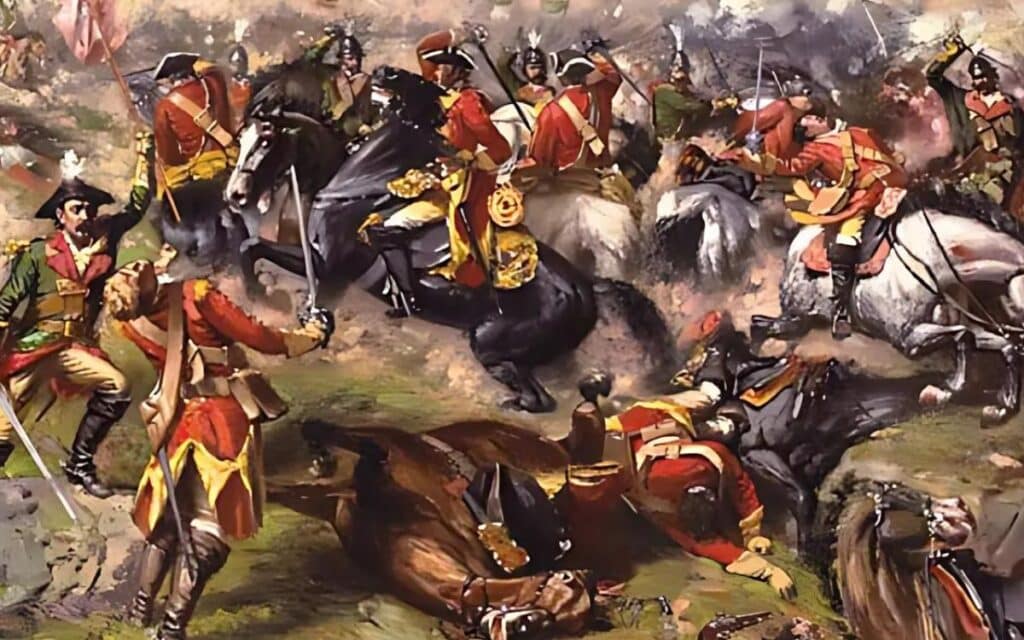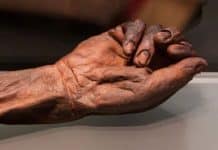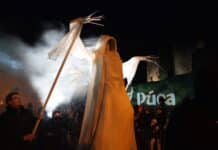With Ireland’s dark history of battle and bloodshed, it’s no surprise that its conflict sites are hotspots for paranormal activity. ANN MASSEY McELROY shares her Top 10 Haunted Irish Battlefields!

10 Haunted Irish Battlefields
This small Emerald Isle has been coveted by so many, from Demigods and Vikings to the English. But the Irish were not going to let go without a fight!
Throughout the island of Ireland, violent battles and tragic bloodshed have seeped into the very earth and the heart of Ériu, goddess of Ireland.
Battle of the Boyne, Drogheda, County Meath
1 July 1690 was the date of the horrendous battle between the Jacobites and Catholic King James II and the soldiers of William of Orange.
The meeting of armies occurred at the River Boyne crossing, now marked by the Mary McAleese Boyne Valley Bridge and at Roughgrange. Due to a change of calendar, the anniversary now falls on 12th July.
The death toll was 2000 soldiers, most of whom were Jacobites. Locals have heard the cries of war, encountered poltergeist activity and seen children running through walls. Just a few miles from the battlefield proper, lies Athcarne Castle.
The defeated ghost of King James has been seen roaming the crumbling ruin. A hanging tree stands, the writhing form of an executed soldier silhouetted against the moonlight and a blood covered female apparition paces the castle boundary, her demented stare chilling to the bone.
Aughrim Battlefield, County Galway
12 July 1691 (now 22 July) saw one of the deadliest battles in history. As the Williamite War continued to rage across Ireland, this battle was the turning point and saw the ultimate defeat of the Jacobites.
Over 7000 soldiers were slain on the battlefield, including many of the Jacobite senior officers, which was the final nail in the coffin for King James II.
The entire village of Aughrim was built over the blood and decaying bodies of the dead. It is little wonder that it is a whole village of hauntings and supernatural occurrences.
The screams of the dying are heard, only muted by the ghostly sounds of cannon fire. Skeletal spectres are seen roaming the streets and close to the Aughrim Interpretative Centre strange mists appear across the fields.
Footsteps echo through the visitor centre and shadows of the fallen appear and fade away. Headless horsemen have been sighted and nothing is more chilling than the sound of battle drums in the dead of night.
Siege of Derry, Derry City Walls, County Londonderry
The city of Derry is famous for its ancient walls and the Siege of Derry took place at this very location. In 1689, the Protestant city of Derry refused to surrender to King James II and his men, locking them out of the city. The attacking forces laid siege and the battle went on for months.
There were many deaths from heavy artillery fire and localised combat. These casualties of war remain and one of the most enduring legends is that of phantom soldiers seen marching along the city’s ramparts – an eternal duty.
Tourists and locals alike have reported hearing the distant sound of cannon fire and wails of anguish at night. The ghost of Governor George Walker, who led the defence of the city, is also rumoured to roam the walls, overseeing the city’s protection in death as he did in life.
Unusually, the old cemeteries of Derry, are thought to be some of the most haunted hotspots of the ancient city – where the fallen were interred. Witnesses have claimed to see apparitions, felt icy chills and reported swirling mists. A city borne of battle and bloodshed seems to have eternal reminders of tragic loss.
Battle of Clontarf, County Dublin
On Palm Sunday in 1014, Vikings and Irish Chieftain rivals of Leinster sought to take the crown of High King Brian Boru. The battle was one of endurance with heavy losses on both sides. Of course being Ireland, a bit of legend has become entwined with history!
Enter an epic battle of good versus evil, magic and Viking arrows dipped in the blood of dragons. Demons and witches waited as wraiths for the fallen and the Banshee of Munster would appear before a Munster man fell.
Legend aside, the battle took place and it served as a death knell for Brian Boru. As the Vikings retreated, Brian Boru prayed in his tent, only to be slain by a fleeing Norseman.
Clontarf (also the birthplace of Bram Stoker) sits on the edge of the Irish Sea, the wild waters echoing back the clash of swords and cries of battle that still hang on the breeze. The spirits of slain warriors from both sides have been reported from Clontarf Castle to the water’s edge.
Battle of Vinegar Hill, Enniscorthy, County Wexford
During the Irish Rebellion of 1798, the Battle of Vinegar Hill took place. Over 15,000 British soldiers, attacked the strategic hilltop position. The Irish rebels numbered 20,000 Irish rebels but they were poorly equipped.
Despite holding strong with sheer determination, the rebels were finally overwhelmed and defeated. The battle marked the turning point of the rebellion in Wexford, but the fierce fighting spirit is still remembered as a symbol of Irish resistance.
The ghosts of battle are believed to remain and visitors have reported sudden cold chills and hearing weak cries under the sound of clashing swords. Some claim to have seen shadow figures and wispy apparitions moving across the hill at dusk – believed to be the restless souls of fallen Irish rebels. The hill’s dark history and tragic loss of life give rise to its reputation as a haunted site in addition to its already significant historical legacy.
Battle of the Yellow Ford, County Armagh
The Battle of the Yellow Ford was fought on 14 August 1598. It was a significant clash during the Nine Years’ War in Ireland.
Irish forces led by Hugh O’Neill, Earl of Tyrone, ambushed an English army near the River Blackwater in County Armagh. The English underwent a devastating defeat, losing around 2,000 soldiers.
Locals tell of ghostly apparitions of soldiers seen close to the river at dawn and dusk. Some have reported hearing the distant sounds of war including sword fighting, screams of pain, and the echo of marching footsteps, all lingering in the fog.
The eerie atmosphere surrounding the battlefield adds to its reputation as a haunted place, where the tragic past seems to remain firmly in the present.
Battle of Kinsale, County Cork
The year was 1601 and it was the final battle of the Nine Years’ War. Spanish allies had landed in Kinsale to support the Irish rebellion, but miscommunication and huge tactical errors led to an overwhelming defeat and the collapse of Ireland’s rebellion.
Locals report strange happenings near the old battlefield, including spectral soldiers, the distant sound of gunfire and eerie whispers. Many say the spirits of the fallen Irish and Spanish forces still wander Kinsale, unable to rest after their crushing defeat.
Battle of Benburb, County Tyrone
The Battle of Benburb took place in 1646, as a part of the Irish Confederate Wars.
Led by Owen Roe O’Neill, Irish forces seriously defeated a Scottish Covenanter army near the River Blackwater in County Tyrone.
Despite being heavily outnumbered, O’Neill’s tactical skills including the use of Tyrone’s rugged terrain gave Irish soldiers the upper hand. They killed or captured over 3,000 men, seriously boosting Irish morale during the Wars of the Three Kingdoms.
Spooked locals have described strange lights and ghostly apparitions hovering over the area as well as the sounds of battle cries and swords in the night.
Battle of Knocknanauss, County Cork
The Battle of Knocknanauss took place in 1647, part of the Irish Confederate Wars. It was a shocking fight, with poor strategy, weak leadership and little coordination. The Irish army was overwhelmed and some 3000 Irish soldiers were slain.
The most shocking part is these deaths took place over just a few short hours of fighting. A couple of hundred more Irish were tracked to nearby woods and executed on the spot days later.
Such a rapid amount of violent death in such a short timespan has left a ghostly imprint, with ghostly fallen soldiers reported as looking bloody and bewildered. Screams of execution and startled horses have also been spoken of by locals.
The Battles of Moytura, Cong, County Mayo and Lough Arrow, County Sligo
The First Battle of Moytura took place just outside the village of Cong and was the start of the battle for Éire.
Today the Glebe Standing Stones remain, the location where Druid High Priests used their powers during battle. Cairns are evident, the final resting places of fallen warrior gods.
The Second Battle of Moytura took place at Lough Arrow and was the ultimate battle between the demigod races of the Tuatha Dé Dannan and the Fomorians.
Although considered mythical, the Battles of Moytura was documented in the Irish Cycles. King Nuada of the Tuatha Dé Danann lost his arm during the battle of good versus evil and as a no longer whole man, had to rescind his throne. Lough Arrow remains a neolithic landscape of intrigue.
While deemed as mythology, there is no doubt that both locations are steeped in Druidic energy and so many visitors have cited mystical, eerie occurrences, from strange lights to chills and energy making hairs stand on end.
Thousands of years of bloodshed and fighting have left an eternal imprint on the landscape of the Emerald Isle.
Fallen soldiers seem to remain, still trying to defend Ireland – ghosts of battle, unable to rest.
Have you seen any paranormal activity on these Irish battlefield sites or any other battlefield for that matter? Tell us about it in the comments section below!








Very good stories, the kind I grew up on . How a story about Kerrigans Keep ?